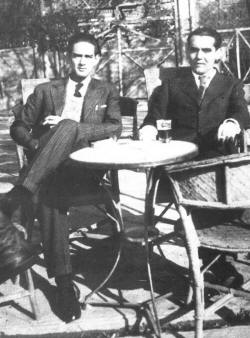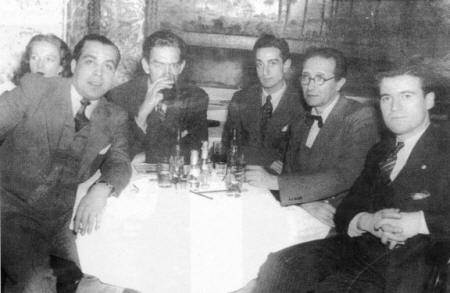

 Ernesto Román Laureano Pérez Guerra, better known as Ernesto Guerra da Cal
(December 19, 1911 - July 28, 1994), was a Galician philologist and writer.
Serafín Ferro was introduced to
what
Federico García
Lorca called epentismo, the circle of homosexuals of the Generation of 27,
with whom the very young A Coruña man related and whose gatherings he
frequented, among others that of the Chilean diplomat and writer
Carlos Morla Linch, to which the two Andalusian poets,
Rafael Martínez Nadal and the Galicians
Eduardo Blanco Amor and
Ernesto Guerra da Cal,
went, and where literature and current affairs were combined with stories of
love and jealousy. Xesús Alonso Montero does not doubt that Lorca and Serafín
"were lovers, although perhaps occasional", and other testimonies coligen that
more than a triangle there could be "a whole love polygon", of which Blanco
Amor, confessed homosexual, would be part; Morla and even Guerra da Cal, both
married.
Ernesto Román Laureano Pérez Guerra, better known as Ernesto Guerra da Cal
(December 19, 1911 - July 28, 1994), was a Galician philologist and writer.
Serafín Ferro was introduced to
what
Federico García
Lorca called epentismo, the circle of homosexuals of the Generation of 27,
with whom the very young A Coruña man related and whose gatherings he
frequented, among others that of the Chilean diplomat and writer
Carlos Morla Linch, to which the two Andalusian poets,
Rafael Martínez Nadal and the Galicians
Eduardo Blanco Amor and
Ernesto Guerra da Cal,
went, and where literature and current affairs were combined with stories of
love and jealousy. Xesús Alonso Montero does not doubt that Lorca and Serafín
"were lovers, although perhaps occasional", and other testimonies coligen that
more than a triangle there could be "a whole love polygon", of which Blanco
Amor, confessed homosexual, would be part; Morla and even Guerra da Cal, both
married.
Ernesto Román Laureano Pérez Guerra was born in Ferrol. After the early death of his father, his mother moved to Madrid to resume his studies at the Escuela Superior Normal, leaving him and his brother in charge of the family of Quiroga, Lugo, the town where he spent his childhood and with which he always retained a deep sentimental bond. When she was just eleven years old her mother obtained a teaching position in Madrid, and took both children with her. Ernesto lived in the capital between the ages of eleven and twenty-five. He studied the baccalaureate and the career of Philosophy and Letters, at the same time as he began to develop a certain political conscience that took to him to participate in the student protests against the dictatorship of Miguel Primo de Rivera, being stopped several times. He also came into contact with the intellectual life of the capital, attending sessions of the Athenaeum and coming into contact with some prominent figures. In 1931 he met Federico García Lorca, a person with whom he will have a great friendship and with whom he will share the republican ideology. In the early years of the Second Spanish Republic, both went together to various social gatherings in the capital, both those of the Casa de las Flores, organized by Pablo Neruda, and those of the Café Regina, of Galician character. Guerra da Cal also attended the founding of La barraca, Lorca's theater group, and put him in touch with some Galician intellectuals, most notably Eduardo Blanco Amor. The relationship between the two is also at the heart of the composition of his book Seis poemas galegos, of which Guerra da Cal would act as one of the instigators and as a punctual linguistic aid. When the Spanish Civil War began, Ernesto went to fight on the Republican side as part of the Galician Militias. In 1937 his poem Mariñeiro fusilado, his first literary publication, appeared in the magazine Nova Galiza. In 1939, the Republican defeat surprised him in New York, fulfilling a mission for the government of the Republic. He was exiled to the American city, where in the early years he came into contact again with Castelao and other exiles. In the United States of America he developed a fruitful academic career. He first held the chair of Romance Languages and Literatures, and later was director of the Department of Spanish and Portuguese at Washington Square College. In those years he published Língua e estilo de Eça de Queirós (1954), one of the most important studies on the Portuguese author. In 1956 also collaborated in Dictionary of English Literature, and Galician Brasileira de Jacinto do Prado Coelho, taking charge of the entries referred to the Galician literature. Also in those years it developed the literary creation, giving to the press books of poems like Lua de alén mar (1959), Poemas (1961), Rio de sonho e tempo (1962) ou Motivos de eu (1966). By adopting American nationality, in 1954 he also legally adopted the name Ernesto Guerra da Cal, applying the Anglo-Saxon rules of name formation, in which the mother's surname goes first, which is why her son Enric bears the surnames. In 1977, now retired, he moved to Estoril, Portugal . In those years he published, among other books, the poems Futuro inmemorial (1985), Deus, tempo, morte, amor y otras bagatelas (1987), Espelho cego (1990) and Caracol ao Pôr-do-Sol. It is noteworthy, both in his academic and literary career, the firm commitment, political and orthographic, with the unity of the Galician-Portuguese language and the space of Lusophone. He died in July 1994 in Lisbon, the city where he is buried.

Guerra da Cal (with a glass in his hand) with Castelao, at a meeting with friends in New York.
My published books: